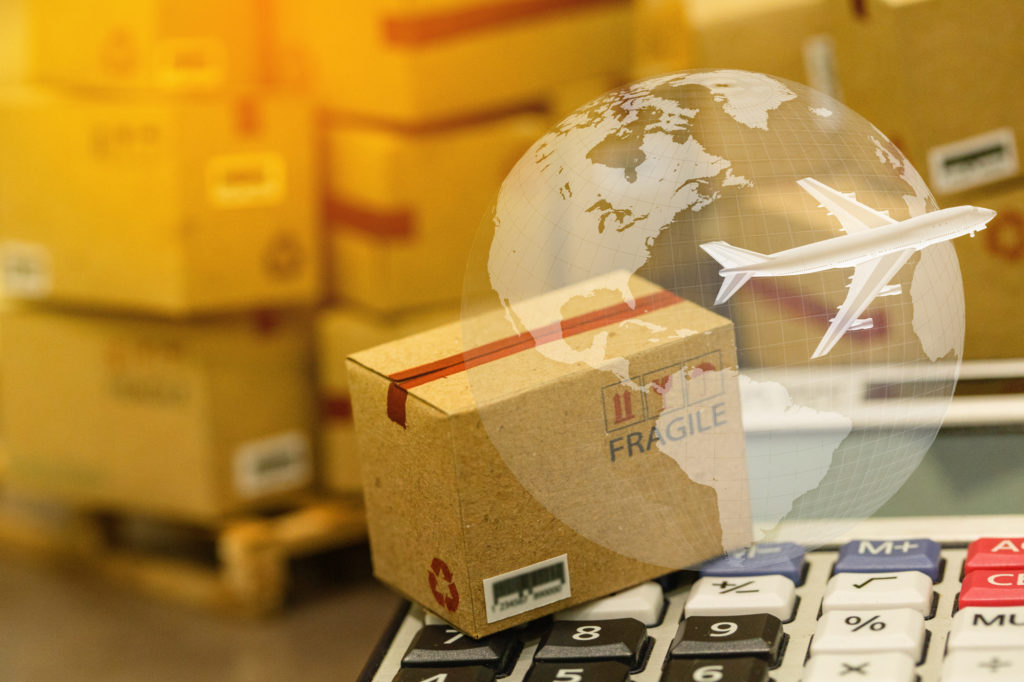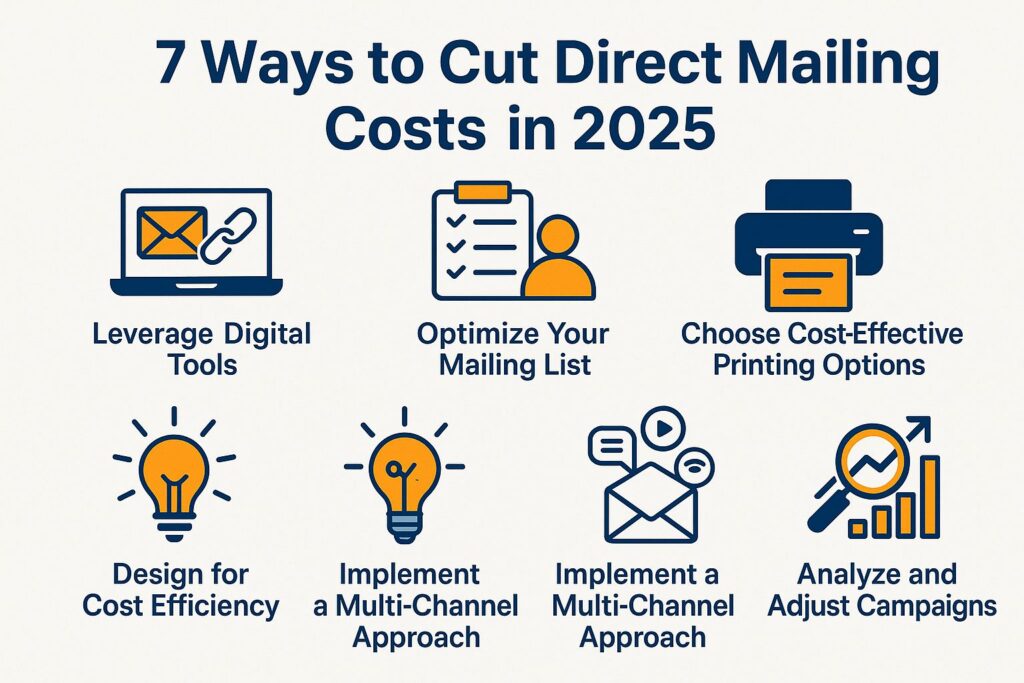
7 Ways to Cut Direct Mailing Costs in 2025
Direct mailing doesn’t have to break the bank. As you prepare for 2025, it’s important to look for methods to reduce costs in your campaigns. Cutting expenses can improve your profits and extend your marketing reach. Learn seven new methods, including using online tools and mail technology, refining your mailing list, and better focusing on your audience, that can change how you handle things. Want to learn these money-saving tips? Let’s look into ways to improve the efficiency and effectiveness of direct mailing.
Importance of Cost Efficiency in Direct Mailing and Budget Management
Implementing cost-efficient strategies in direct mailing can reduce overall marketing expenses by up to 30%, significantly enhancing customer engagement and ROI optimization.
To achieve these savings, consider using specific targeting through grouping.
By analyzing customer data, such as purchase history and demographics, you can tailor your mailings effectively.
Tools like Mailchimp and Constant Contact offer advanced features that allow you to create targeted lists, which can improve response rates and lower costs per acquisition.
Using A/B testing on various email styles can show what works best with your audience, resulting in better campaigns without raising costs, thus improving marketing efficiency and response rates.
Overview of Direct Mailing in 2025 and Modern Marketing Techniques
In 2025, direct mail is using a mix of old and new approaches, raising response rates by 15% compared to earlier years.
Marketers are using data analysis and custom content to adjust their mailings. For instance, using CRM systems like HubSpot can help segment audiences based on previous purchasing behavior, allowing for highly targeted campaigns.
Integrating QR codes in mail pieces can bridge the gap to digital, encouraging consumers to engage online. Brands such as Coca-Cola have successfully employed these tactics, witnessing significant engagement spikes.
By regularly reviewing customer opinions and choices using tools like SurveyMonkey, companies adjust their plans to stay relevant in a fast-changing market through data-driven decisions.
Way 1: Use Online Tools and Digital Options
Using digital tools can make your mailing tasks easier and lower expenses, creating a better plan to reach people through strategic planning and cost-effective solutions.
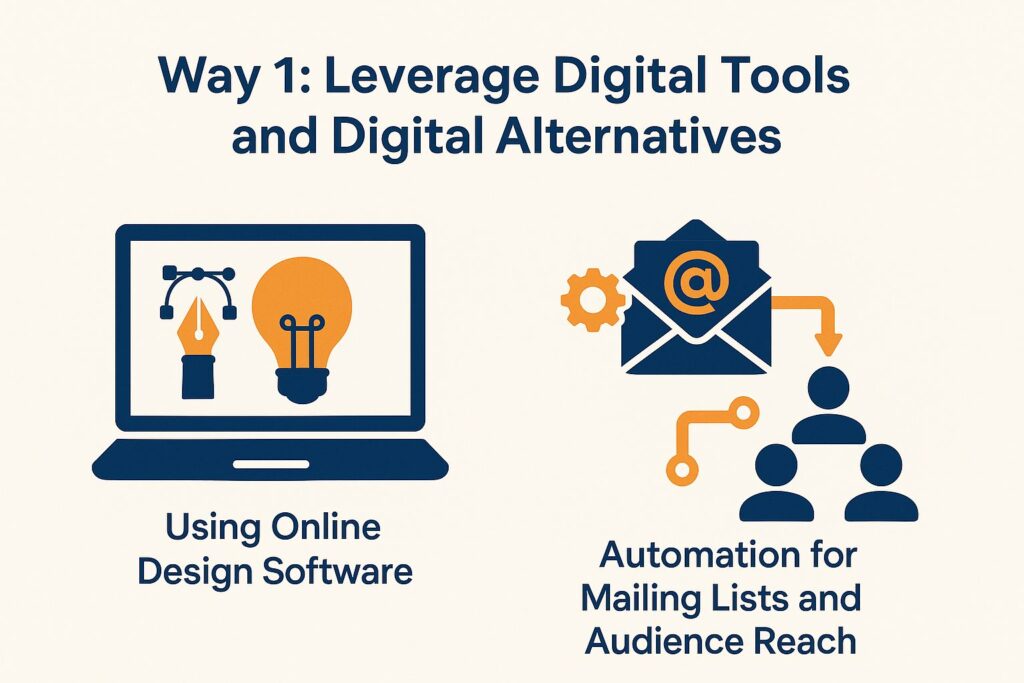
Using Online Design Software for Creative Design
Tools like Canva ($12.95/month) and Adobe Express ($9.99/month) let marketers create attractive mail pieces without requiring professional graphic design skills.
To create effective direct mail designs, start by selecting a template that aligns with your brand’s messaging. For example, Canva provides many templates that you can adjust for promotions or events.
Next, use good images that relate to your service or product; Adobe Express lets you quickly bring in and change images. Use a clear call to action like ‘Visit us for 20% off’ to encourage a response.
Use the same colors and fonts on all your materials to make your brand easily recognizable.
Automation for Mailing Lists and Audience Reach
Mailchimp, which costs between free and $299 per month, helps organize mailing lists and provides choices for grouping contacts to improve targeting.
To set up your mailing list that sends emails automatically, begin by adding contacts using CSV files or by connecting with platforms such as Shopify or WordPress.
Next, segment your audience based on demographics such as age and location to tailor your messages better. For example, if you sell sporting goods, you might want different campaigns for males aged 18-25 and females aged 30-40.
Monitor how well your emails are doing by looking at statistics like open rates and click-through rates. Adjust your emails to better fit the interests of each group. Over time, this leads to improved engagement and conversions (see also: How Much Does it Cost to Rent a Postage Meter in 2023?).
Way 2: Improve Your Mailing List for Better Interaction and Productivity
Updating your mailing list often can increase engagement by 25% and lead to better campaign outcomes.
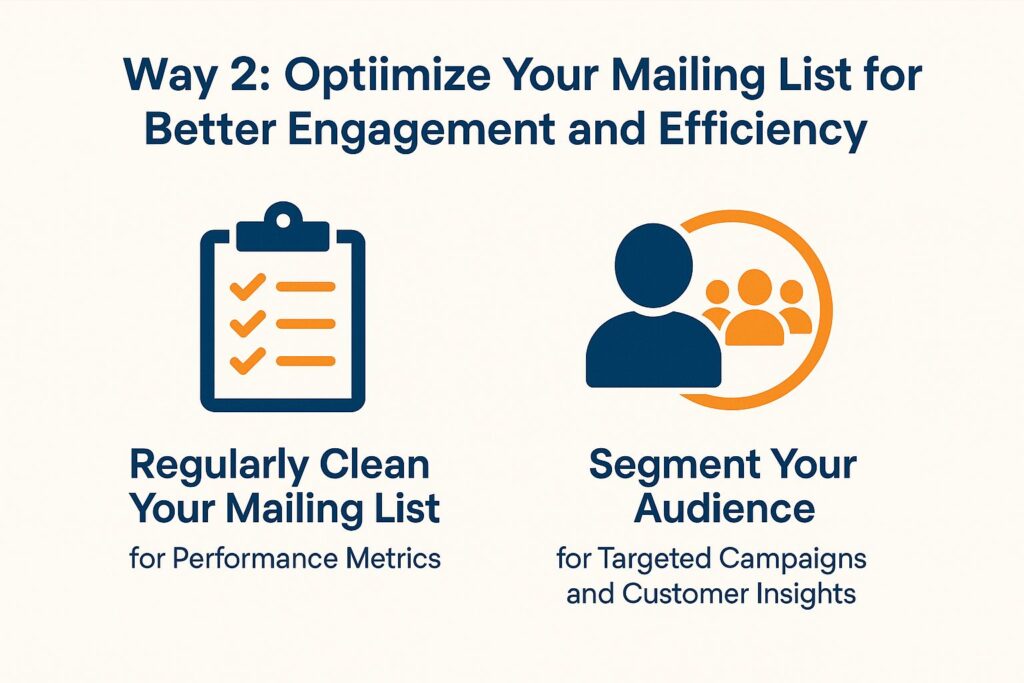
Regularly Clean Your Mailing List for Performance Metrics
Removing inactive contacts from your mailing list twice a year can reduce bounce rates by 20%, leading to better campaign performance.
To clean your mailing lists properly, use a tool like NeverBounce, which costs about $0.008 per email. This service identifies invalid or temporary addresses to improve deliverability.
Next, manually verify the engagement of your recipients by tracking open rates; consider removing contacts who haven’t interacted in the last year.
Use a two-step confirmation for new subscribers to verify their interest, which helps keep your list active and involved. This method guarantees your campaigns connect with real potential customers.
Split Your Audience for Targeted Campaigns and Grasp Customer Needs
Splitting your audience into groups can increase open rates by 14% and click-through rates by 10%, making your campaigns more successful.
To segment your audience effectively, consider their behavior, demographics, and previous interactions. For example, use tools like Google Analytics to track user engagement, identifying those who frequently visit your site yet don’t convert.
You can then design targeted campaigns focusing on their interests, such as special offers or educational content related to their browsing history.
Platforms like Mailchimp let you divide your audience by characteristics, allowing you to create targeted email campaigns that connect better with your readers. Using these strategies can greatly improve how your campaign works.
Way 3: Choose Cost-Effective Printing Options to Cut Costs
Picking the correct printing options can cut your costs by up to 40%, helping you manage your marketing budget better.
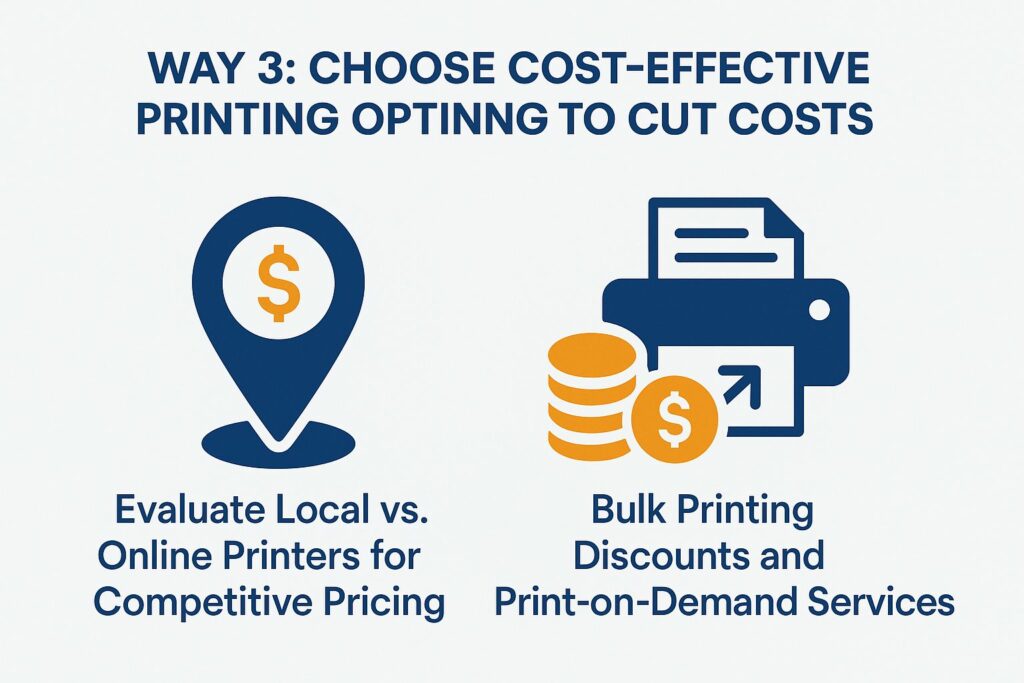
Evaluate Local vs. Online Printers for Competitive Pricing
Evaluating services like Vistaprint (starting at $19.99) versus local print shops can lead to savings of 15-30% depending on your volume needs.
Consider the following aspects to determine the best option for your project.
Local print shops often offer personalized service and fast turnaround, making them ideal for last-minute projects. They may have higher costs, especially for large quantities.
In contrast, online services like Vistaprint provide competitive pricing and extensive templates but can lack the personal touch. If you prioritize speed and customization, a local shop might be worthwhile; for cost-effectiveness and a wider variety, online options are beneficial.
Assess your project timeline and budget to make an informed choice.
Bulk Printing Discounts and Print-on-Demand Services
Many printing companies offer discounts for bulk orders, with potential savings of up to 50% for orders over 1,000 pieces.
To negotiate these discounts effectively, start by researching specific companies that offer bulk pricing, such as Vistaprint or Moo.
Reach out directly via email or phone, clearly stating your volume and asking about tiered pricing options. For example, a local marketing agency saved 30% on 5,000 brochures by presenting a competitive quote from a rival printer.
Consider establishing a recurring order agreement, which can often lead to further discounts. Always ask for promotional offers or loyalty programs that may apply.
Way 4: Use Postage Discounts to Save Money
Using postage discounts can greatly reduce your mailing expenses, with savings of up to 30% for bulk mail.

Bulk Mailing Rates and Postal Services
Knowing USPS bulk mailing rates can lower mailing costs by about $0.20 for each item in large campaigns.
To qualify for bulk mailing rates, you typically need to send a minimum of 200 pieces of mail and meet specific preparation standards.
- Start by gathering your mailing list and segmenting it based on your audience.
- To target local areas, use USPS’s Every Door Direct Mail (EDDM). It allows you to send mail without needing exact addresses.
For example, if you send 1,000 pieces at the regular rate of $0.55, switching to bulk could save you $200, bringing your total down to $350.
Think about using mailing software like Stamps.com to make sending mail easier and follow USPS rules.
Using Pre-sorted Mail Services and Channel Integration
Using pre-sorted mail services can lower postage costs by as much as 18%, which is appealing for businesses that send a lot of mail.
To use pre-sorted mail, you need to organize your mailing lists as per USPS rules. This involves organizing by ZIP code and checking that the barcodes are accurate. After this, integrate the pre-sorted mail into your direct mail campaign by selecting a reliable printing service that offers this option.
Tools like Neoserra and USPS’s Every Door Direct Mail can make handling your list easier and help you follow rules. This approach cuts mailing expenses and quickens delivery, improving the productivity of your marketing efforts.
Way 5: Design for Cost Efficiency and Marketing Effectiveness
Designing with cost savings in mind can lower production costs by up to 15%, improving the success of your direct mail campaigns.
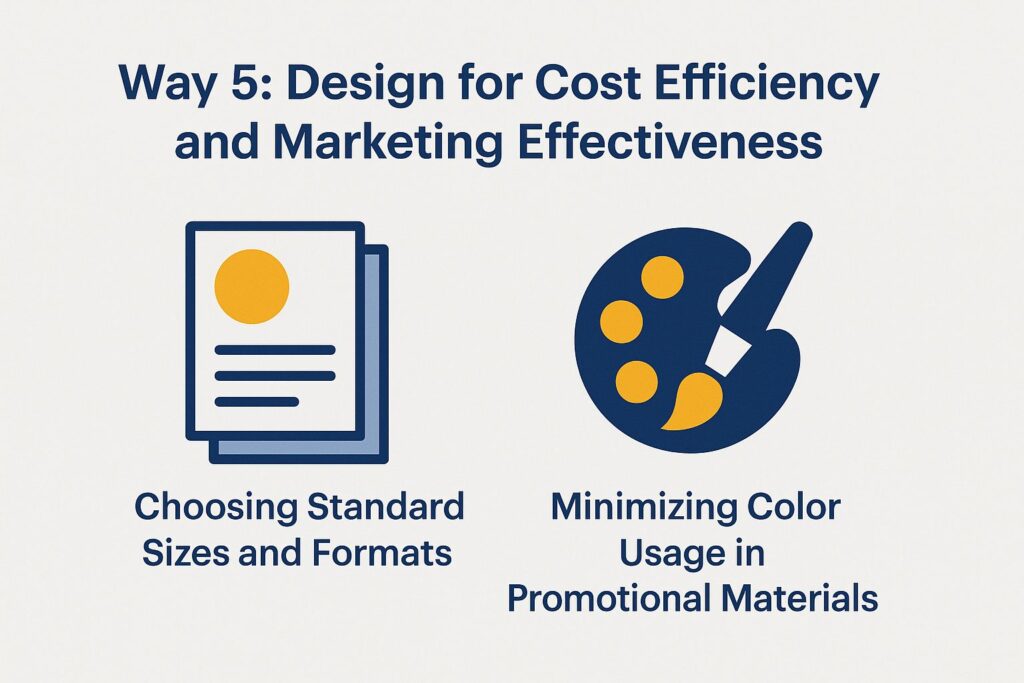
Choosing Standard Sizes and Formats for Design Optimization
Choosing standard sizes like #10 envelopes can reduce printing and postage costs by up to 20% compared to custom dimensions.
For instance, #10 envelopes, measuring 4.125″ x 9.5 fit standard check sizes and can be printed for around $0.05 each in bulk. On the other hand, custom envelopes raise expenses and make mailing more difficult.
Legal-sized envelopes (9.5″ x 15″) fit postal rules and offer more room for extra papers without added charges.
By correctly figuring out shipping information, businesses can improve their mailing processes to save time and money.
Minimizing Color Usage in Promotional Materials
Minimizing color usage in print materials can lead to savings of 30-50% in printing costs, particularly when using full-color printing.
To achieve impactful design with limited color, consider employing monochrome palettes. For instance, a brochure can use various shades of a single color to create depth while emphasizing the brand’s visual identity.
Tools like Adobe InDesign facilitate this approach by allowing designers to easily manipulate color intensity. The Apple catalog effectively uses black-and-white pictures with one vivid color for key elements, creating a striking and cost-effective print design.
Way 6: Implement a Multi-Channel Approach
Using multiple methods can expand customer contact by 40%, by mixing old and new strategies for the best outcome.

Integrating Digital Marketing with Direct Mail
By integrating digital marketing efforts with direct mail campaigns, businesses can achieve a 33% higher response rate due to cohesive messaging.
To effectively blend these strategies, start by creating a unified campaign message across all channels. Use Mailchimp for sending email newsletters and Canva for creating attractive direct mail materials.
Schedule your email campaigns to align with mail drops, ensuring recipients get the same message within a week. Track engagement using Google Analytics for digital channels and include QR codes on direct mail to direct recipients online.
This single approach makes your message clearer and increases customer interaction, resulting in more sales.
Tracking ROI Optimization Across Channels
Tracking the return on investment (ROI) for various channels helps make data-driven decisions, ensuring marketing money is used effectively.
To evaluate the success of your campaigns across different channels, use tools such as Google Analytics and HubSpot.
Google Analytics helps you understand how people use your website, showing data like how often users complete a purchase and how long they stay on your site. Set up goals to monitor specific actions, such as newsletter sign-ups or product purchases.
HubSpot provides detailed reporting tools that link your marketing activities to income. By looking at where your leads come from and how often they result in sales, you can adjust your strategy to concentrate on the channels that bring in the most profit.
Way 7: Analyze and Adjust Campaigns
Reviewing and updating campaigns regularly can increase their effectiveness by up to 20%, ensuring that outreach strategies remain successful.
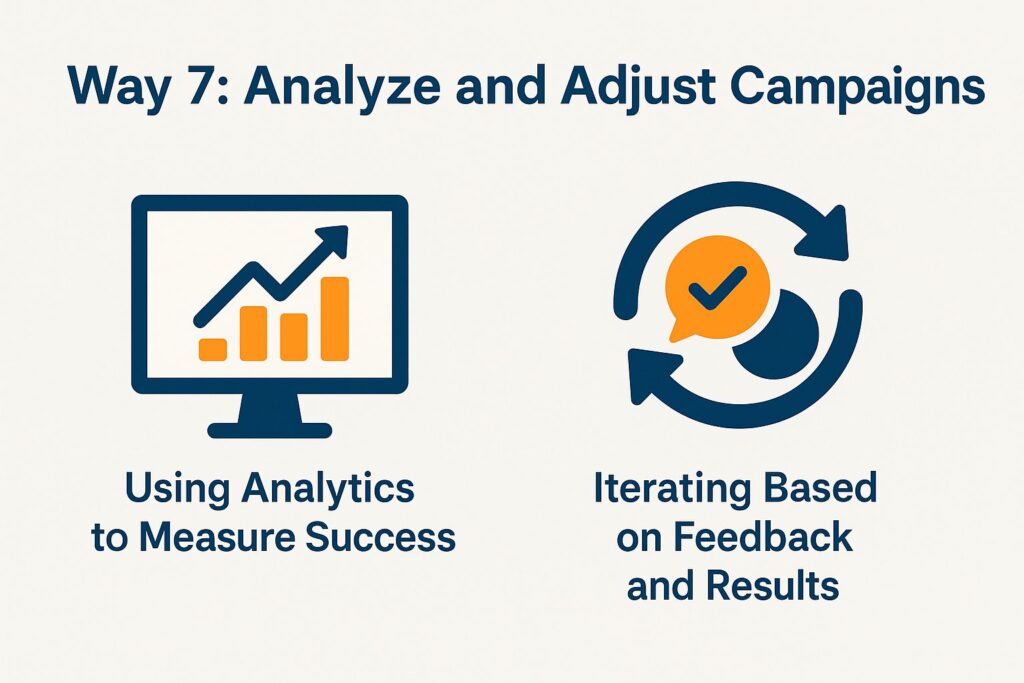
Using Analytics to Measure Success
Analytics tools such as Google Analytics or Mailchimp’s reporting features can show which parts of your campaign worked well and where you can make changes.
To effectively measure your mailing campaigns, focus on key metrics such as open rates, click-through rates (CTR), and conversion rates.
For instance, track open rates to assess subject line effectiveness; a high rate indicates strong engagement metrics.
Next, check click-through rates to see which links connect with your audience-change your content based on this information.
Conversion rates show how many people responded as intended, helping you improve your calls to action and overall plan.
Regularly reviewing these KPIs will help improve upcoming campaigns.
Using Postage Meters to Slash Mailing Costs
Postage meters are one of the most effective ways businesses can cut direct mail costs. Instead of relying on standard postage rates, a meter automatically applies discounted USPS commercial rates, saving up to 9% on First-Class Mail and even more on bulk shipments. These machines also eliminate the need for stamps, reduce manual errors, and streamline the mailing process by printing postage directly on envelopes or labels. For companies that send high volumes of mail, this automation not only saves time and labor costs but can also result in thousands of dollars in annual postage savings.
Iterating Based on Feedback and Results
Feedback systems help make campaigns better by enabling continuous changes, leading to increased participation and better reply rates.
To effectively collect feedback, consider using tools like SurveyMonkey for detailed surveys, Google Forms for quick questionnaires, or social media polls for immediate reactions.
After gathering feedback, categorize the responses to identify common themes. For instance, if many users express confusion about your messaging, revise your campaign by clarifying your key points or simplifying the language.
Use this feedback to continually make your campaigns better, forming a cycle that keeps your audience engaged and involved, which helps build brand loyalty and manage customer relationships.
About the Author
Ethan Cole is a business growth advisor and serial entrepreneur with over two decades of hands-on experience helping startups and small businesses thrive. With a background in finance and operations, he’s led multiple companies from early-stage concepts to multi-million-dollar exits. Ethan specializes in scaling strategies, cost reduction, and building systems that support sustainable growth. As a content contributor for Kwote Advisor, he shares practical insights to help business owners make smarter decisions when launching, managing, and expanding their ventures.


